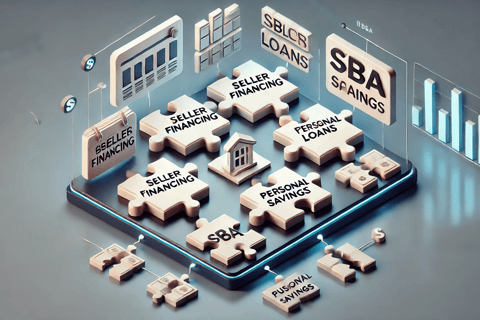Maximizing Business Success: A Comprehensive Guide to Buying and Financing an Existing Business
Unlock the secrets to successful business ownership with our comprehensive guide on buying and financing an existing business. Discover the advantages of acquiring an established enterprise, from immediate cash flow to loyal customer bases, and learn how to evaluate opportunities, secure the best financing, and drive long-term growth. Whether you're a seasoned entrepreneur or just starting out, this guide offers valuable insights and strategies to help you achieve financial success and build a thriving business.
8/12/202410 min read


Embarking on the journey of entrepreneurship is a dream for many, but the path to owning a successful business doesn’t always start with an original idea or a brand-new venture. In fact, one of the most effective ways to enter the world of business ownership is by purchasing an existing business. This approach offers a unique set of advantages, including immediate cash flow, established customer bases, and proven operational systems—all of which can significantly reduce the risks and challenges typically associated with starting a business from scratch.
However, buying an existing business is not without its complexities. From evaluating the financial health of the business to securing the right type of financing, there are many factors to consider to ensure a successful acquisition. This guide will walk you through the key benefits of buying an established business, the critical steps for assessing its value, and the various financing options available to make your purchase a reality. By weaving together expert insights and practical advice, this article aims to equip you with the knowledge you need to navigate the process of buying a business with confidence and to set yourself up for long-term success.
Section 1: The Advantages of Buying an Existing Business
1.1 Immediate Cash Flow and Financial Stability
One of the most compelling reasons to buy an existing business is the immediate cash flow that comes with it. Unlike a startup, where it can take months or even years to see a profit, an established business already has revenue streams in place. From the very first day of ownership, you have money coming in, which can be used to cover operational costs, repay any financing, and even reinvest in the business. This instant financial stability is a significant advantage, reducing the pressure on new owners and allowing them to focus on growth rather than merely surviving.
Additionally, the financial history of an existing business provides invaluable insights. With access to historical financial data, you can make informed decisions about budgeting, forecasting, and strategic planning. You can see which areas of the business are most profitable, identify any cost-saving opportunities, and better understand the financial dynamics of the industry. This transparency reduces the risks associated with financial uncertainty, making it easier to manage the business effectively from the start.
1.2 Established Customer Base and Market Presence
Another major benefit of purchasing an existing business is the immediate access to a loyal customer base. Building a customer base from scratch can be a time-consuming and costly process, with no guarantee of success. However, when you buy an established business, you inherit a network of customers who are already familiar with the brand and its products or services. This not only ensures a steady stream of revenue from day one but also provides a foundation for future growth.
In addition to customers, an existing business often comes with significant brand goodwill. Goodwill is the intangible value that a company has built up over time, including its reputation, customer loyalty, and brand recognition. This can be a powerful asset, especially in competitive markets, as it gives the business a head start and helps maintain its market position. Customers who trust and recognize the brand are more likely to remain loyal, making it easier to retain and attract new business.
1.3 Operational Advantages: Trained Staff and Existing Systems
One of the most overlooked benefits of buying an existing business is the operational head start it provides. When you purchase a business, you inherit not just the physical assets and customer base, but also a team of trained employees who understand how the business operates. These employees bring with them a wealth of knowledge and experience that can be invaluable during the transition period. They know the ins and outs of the business, including its strengths and weaknesses, and can provide insights that help you improve operations and drive growth.
Moreover, established businesses typically have systems and processes in place that have been refined over time. Whether it’s inventory management, customer service protocols, or financial accounting, these systems provide a blueprint for running the business efficiently. Even if these processes aren’t perfect, they give you a solid foundation to build on, saving you the time and effort of developing everything from scratch. This operational continuity is a significant advantage, allowing you to focus on strategic improvements rather than day-to-day operational challenges.
Section 2: Evaluating a Business for Purchase
2.1 Understanding Cash Flow and Risk
Cash flow is the lifeblood of any business, and it’s the primary metric used to determine a business’s value. When evaluating a business for purchase, it’s crucial to analyze its cash flow thoroughly. This includes reviewing financial statements, tax returns, and cash flow reports to assess the consistency and sustainability of the business’s income. A business with strong, predictable cash flow is more likely to be a stable investment, providing the financial security needed to cover operating expenses, service debt, and generate profits.
However, cash flow alone doesn’t tell the whole story—risk is an equally important factor to consider. A business with high cash flow might still be a risky investment if it operates in an unstable industry, relies heavily on a small number of customers, or is overly dependent on the current owner. Assessing risk involves looking at factors such as the business’s market position, the longevity of its operations, and the diversification of its revenue streams. A lower-risk business is typically more valuable because it offers greater stability and predictability, making it a safer bet for investors.
2.2 Due Diligence: Financial and Operational Assessment
Due diligence is the process of thoroughly investigating a business before committing to a purchase. This step is critical in identifying any potential issues that could impact the business’s value or your ability to operate it successfully. Start by reviewing the business’s financial statements, including its balance sheet, income statement, and cash flow statement. These documents provide a clear picture of the business’s financial health, including its assets, liabilities, revenues, and expenses.
Beyond the financials, it’s also essential to assess the business’s operations. This includes evaluating supplier relationships, employee satisfaction, customer feedback, and the efficiency of existing systems and processes. Understanding these operational aspects can help you identify areas for improvement and determine whether the business has the infrastructure needed to support future growth. Additionally, consider conducting a credit check on the business to ensure there are no outstanding debts or liabilities that could affect your ownership.
2.3 Seller Financing as a Strategic Tool
Seller financing is an increasingly popular option in business acquisitions, offering benefits to both buyers and sellers. In a seller financing arrangement, the seller acts as the lender, allowing the buyer to make payments over time instead of paying the full purchase price upfront. This can be particularly advantageous for buyers who may not have access to traditional financing or who want to reduce their initial capital outlay.
For sellers, offering financing can broaden the pool of potential buyers, making it easier to sell the business quickly and at a favorable price. However, it’s important to negotiate the terms of seller financing carefully. Key elements to consider include the interest rate, repayment schedule, and any collateral required to secure the loan. Combining seller financing with other financing methods, such as SBA loans or personal savings, can help you cover the full purchase price while minimizing risk.
Section 3: Financing the Purchase of an Existing Business
3.1 Types of Cash Flow Financing
When it comes to financing the purchase of an existing business, there are several options available, each with its own advantages and drawbacks. Understanding these options can help you choose the best financing method for your specific situation.
Business Credit Cards: These are ideal for covering short-term operational costs that can be paid back quickly. While they offer easy access to funds, their high APRs make them less suitable for large-scale financing.
Term Loans: These loans provide a lump sum that is repaid over a fixed period, usually with a competitive interest rate. Term loans are best for established businesses looking to make significant investments that will generate steady cash inflows.
Credit Lines: Similar to business credit cards but with lower interest rates, credit lines offer flexibility in managing cash flow gaps. They are particularly useful for businesses with seasonal revenue fluctuations or periodic cash needs.
Invoice Financing: This option allows businesses to borrow against their accounts receivable, providing immediate cash flow to meet short-term needs. It’s best suited for companies with a strong history of sales on credit and reliable customers.
Merchant Cash Advances: These provide upfront capital in exchange for a percentage of future credit card sales. While they offer quick access to funds, the cost of capital can be high, making them a last-resort option for businesses with limited financing alternatives.
3.2 Combining Financing Methods
In many cases, a single financing method may not be sufficient to cover the full purchase price of a business. Combining multiple financing sources can help you fill any funding gaps and reduce your overall financial risk.
Seller Financing and SBA Loans: One common strategy is to combine seller financing with an SBA loan. This allows you to secure the majority of the purchase price through a low-interest loan while using seller financing to cover the remaining balance.
Personal Savings and Credit Lines: Another approach is to use personal savings for the down payment and a credit line to manage ongoing operational costs. This minimizes the amount of debt you need to take on while providing flexibility in managing cash flow.
401(k) Rollovers and Term Loans: For buyers with substantial retirement savings, a 401(k) rollover can be used to fund part of the purchase, reducing the need for traditional loans. The remaining balance can then be financed through a term loan, providing a balanced approach to financing.
3.3 Best Practices for Managing Business Debt
Once you’ve secured financing and purchased the business, managing debt effectively is crucial to ensuring long-term success. Here are some best practices to keep in mind:
Monitor Cash Flow Regularly: Keep a close eye on your cash flow to ensure you can meet all debt obligations without straining the business. Use tools like cash flow calculators to track income and expenses and identify any potential issues early.
Optimize Debt Payments: Always aim to make timely payments to avoid penalties and maintain a good credit rating. Consider setting up automatic payments or reminders to ensure you never miss a due date.
Refinance When Possible: If you find yourself with a higher-interest loan, explore opportunities to refinance at a lower rate. This can reduce your monthly payments and free up cash for other business needs.
Section 4: Ensuring Long-Term Success After the Purchase
4.1 Leveraging Systems and Staff for Growth
After purchasing an existing business, one of your primary goals should be to leverage the systems and staff that are already in place to drive growth. Start by conducting a thorough review of the business’s operations, identifying any areas where improvements can be made. Engage with your employees, tapping into their knowledge and experience to uncover inefficiencies or potential opportunities.
Consider implementing new technologies or processes that can enhance productivity and streamline operations. Whether it’s upgrading your inventory management system or automating routine tasks, these improvements can help you scale the business more effectively. Additionally, focus on employee development and retention by offering training programs, career advancement opportunities, and a positive work environment. A motivated and skilled workforce is essential for sustaining growth and achieving long-term success.
4.2 Strategic Growth: Expanding Locations and Services
As your business stabilizes and grows, consider expanding its footprint by opening new locations or adding new services. This can increase your market share and revenue potential, but it requires careful planning and execution. Start by analyzing market trends, customer demand, and the competitive landscape to identify the best opportunities for expansion.
When opening new locations, consider factors such as location visibility, customer accessibility, and the potential for synergies with your existing operations. For service expansion, focus on offerings that complement your current products or services and meet the needs of your customer base. By strategically expanding your business, you can build on its existing strengths and create new revenue streams.
4.3 Continuous Evaluation and Adaptation
In today’s fast-paced business environment, continuous evaluation and adaptation are key to staying competitive and successful. Regularly review your business’s financial performance, operational efficiency, and market position to identify areas for improvement. This will help you make informed decisions and keep the business on track for sustained growth.
Stay agile by being open to change and ready to adapt to new challenges and opportunities. Whether it’s shifting market dynamics, evolving customer preferences, or technological advancements, being proactive in your approach will ensure that your business remains resilient and successful in the long run.
Conclusion
Purchasing an existing business offers a unique opportunity to step into entrepreneurship with a head start, leveraging established cash flow, loyal customers, and proven operational systems. By carefully evaluating the business, securing the right financing, and strategically managing your debt, you can set yourself up for long-term success. Remember, the key to thriving in your new venture lies in continuously optimizing operations, engaging with your team, and staying flexible to adapt to market changes.
At BRC Holy Trust, we believe in the power of businesses not just to generate profits, but to make a meaningful difference in the world. We are committed to empowering charitable organizations that help children in need by donating to them and supporting their causes. Your support can make a significant impact—by donating to BRC Holy Trust, you directly fund our ongoing efforts to help these organizations continue their vital work. Together, we can create a brighter future for children and strengthen the communities they live in. Join us in this mission, and help us help those who need it most.
























Change Lives
Supporting charitable organizations, providing assistance to children worldwide.
703-678-7628
© BRC Holy Trust 2024
